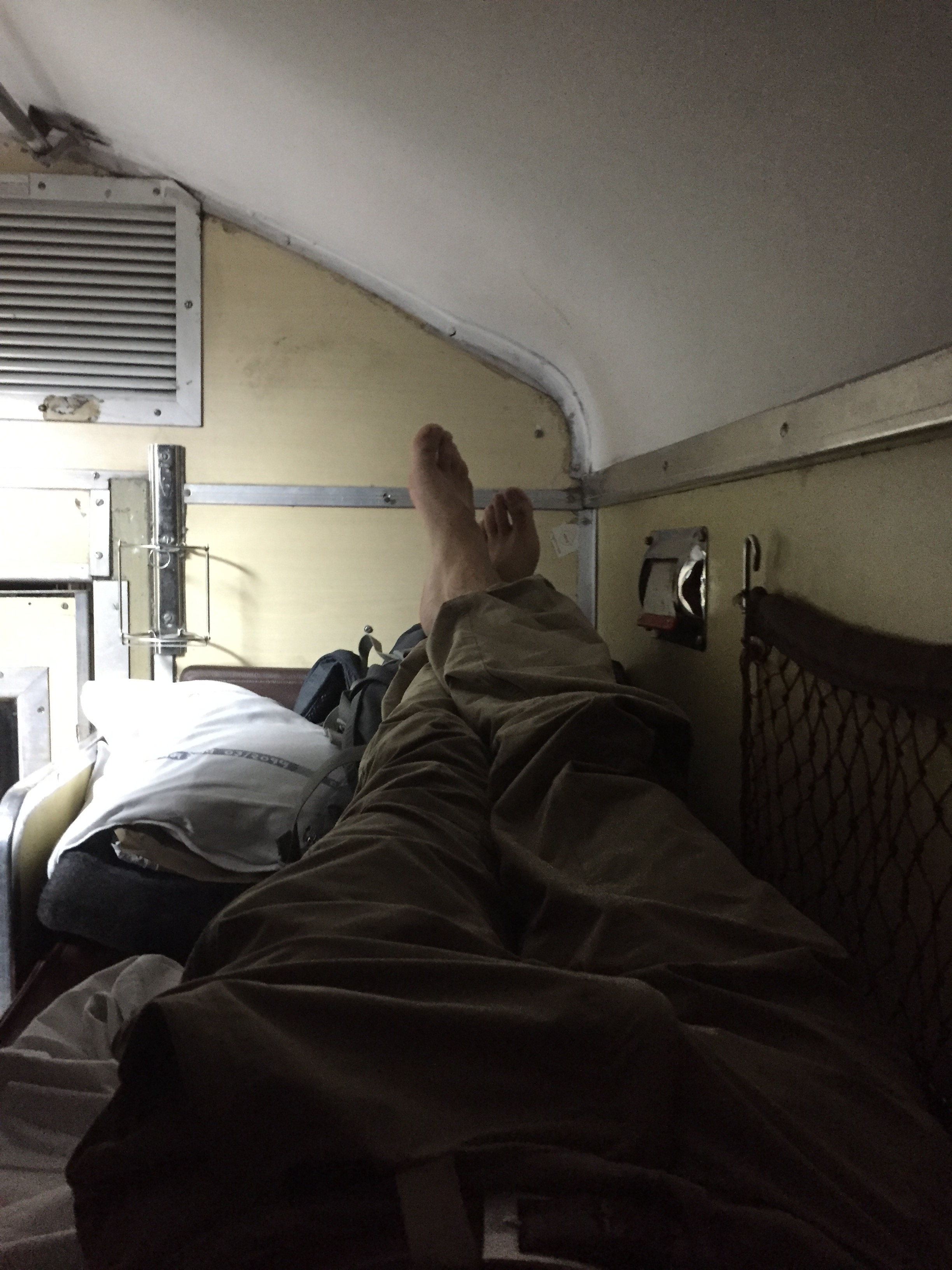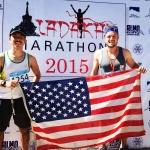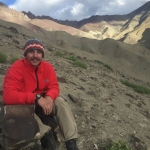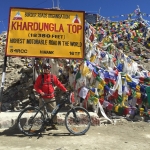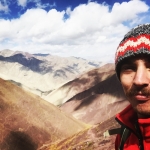About a month ago someone mentioned that I should visit Ladakh, a Himalayan region of northern India famous for its beauty. At the time, I was Googling around for running races in India. On a whim, I typed in “Ladakh Marathon” into the search bar and clicked on the first link. To my surprise, the Ladakh Marathon actually existed! Yet, I quickly realized this wasn’t just any race. It was the highest marathon in the world, and it was starting in 29 days. I signed up.
I want to be clear and say that I funded this trip personally, and it was not connected to my Minerva Fellowship. September is a slow month at Bagru Textiles (monsoon season), so I figured this would be a good time to explore another part of India – embracing the culture, challenging myself, and engaging with all the ideals which the fellowship entails.
At this point I also started emailing friends, asking begging them to join. One of my childhood friends, Ben Tillotson, was the only one crazy enough to agree. Ben was traveling in the Middle East and booked a one-way ticket to Leh, Ladakh, India.
My 29 days of training were admittedly rushed and inadequate. Bagru is not the best environment to train for a marathon, let alone one at altitude – but to be fair, it makes up for it in its beauty. I started a strict 3-week training regiment. I woke up at 5:30 every day, running to and through nearby villages, exploring farmlands within the Rajastani desert. The preparations for these runs were time-consuming: ensuring I had enough bananas, almonds, and purified water (energy bars don’t exist here), battling the heat (still reaching 100 degrees Fahrenheit in Bagru), and making sure I had enough clean-ish clothes (more challenging than you think). By the time I left, I had only been able to put down two “long runs” – one 13 miler, and one 20 miler. For those of you unversed in marathon training, this isn’t considered ample training, but still put me in a position where I knew I could finish the race.
The first day you arrive in Leh you must rest. This is essential for acclimatization. There are even announcements in the airport about it. Not having slept a wink, Ben and I passed out for a few hours and then were eager to check out the town. Leh is a unique place – it is capital of Ladakh, a local mixture of practicing Muslims, Buddhists, and Hindus, and a culture that many feel is more Tibetan than Indian. And, to add, the town is completely run by the tourist industry. Every-other store in Leh is a travel agency, advertising multi-day Himalayan hikes, rafting adventures, mountain biking, and more. We took part in all of them during our stay.
A side note: Over 80% of the tourists in Leh are Israeli. This made us feel right at home as two Jewish boys traveling in northern India. Leh is a popular destination for recently-retired Israeli soldiers before they head down to Manali, Delhi, and Goa. L’Chaim!
After about an hour of walking around town I began to feel sick and started to vomit. Ben and I assumed this was altitude sickness and, after the vomiting didn’t stop, we ventured to the hospital. My first hospital visit in India was a delight; the doctor informed me that my oxygen levels were fine – merely a stomach virus – and after getting pumped with fluids I walked out without having to pay a cent. Excellent healthcare.
The next few days were full of acclimatizing adventures. Sleeping is difficult, as you wake up at different points due to the lack of oxygen. White water rafting in the Zanskar river, floating between Himalayan monstrosities, was a true privilege. We also did a two-day trek to Stok (the highest mountain in the Ladakhi range). During our hike we stayed in a Ladakhi homestay in the mountains. At night the temperature dropped to around 35 degrees, but the fresh air gave me solace. The next day we passed over Stok La, which brought us to 16,000 feet – nearly the elevation of Mt. Everest Base Camp. At this altitude you have to stop every 10-20 steps to catch your breath. Altitude simply isn’t something you can “power through.” The harder you push, the worse you feel. Meanwhile, our local guide Jintek was chain-smoking cigarettes and nearly running up the trail.
We went for two runs in Leh before our marathon and both were disasters. The first run was a nice 6-miler up Khardungh La, the highest motorable road in the world. We had to stop every half mile. For those familiar with running, you will know how extreme this sounds – and it was a daunting reality. The second run was a four miler that was equally as taxing on the inclines. We went into the marathon confident that we were acclimatized well enough for the distance, but concerned for the final 6 miles that were uphill. Going off our two our training runs, we were prepared to set timers on our watches and switch to run/walk intervals for the final 6.
Ben and I spent our pre-race dinner eating vegan pizza and debating what song would be our alarm in the morning. Finally, race day. We woke up at 4am to ACDC’s “Highway to Hell” and were stoked as ever. The morning was hectic. Foolishly race day came and we didn’t know where the start was. We knew it was close, but ended up being much farther than we thought. I spent too much time rolling out my calf with my Nalgene and not enough time walking to the start line.
We arrived with about 10 minutes to spare. After a bathroom emergency, broken headphones, race numbers falling off, and strange looks at our singlets, we set off on the highest marathon course in the world. Ben and I decided to run our own races, so after mile 1 I gave him a high-five and watched him run ahead with a lead pack.
The first 10 miles were on a slight downhill, so I felt good and settled into a sub-8 minute pace.
Ladakh is cherished by its inhabitants. The locals take great pride in their pristine land in India, which acts as a stark contrast to famous bustling cities like Delhi and Bombay. Tourists actually need to buy permits to explore different areas of Ladakh and there are signs everywhere to respect the land (nowhere else in India does this mentality exist). The Ladakh Marathon offers 4 distances: 7km, 21km (half marathon), 42km (full marathon), and 72km (highest ultra in the world). With a total of over 7,000 runners and distances for all ages, the Ladakh Marathon event has become a community affair in Leh with the goal to make Ladakhis more active in their beautiful environment.
I found myself running alongside Ladakhi high school students for the first ten miles. Some were wearing scarves and sweatpants, decade-old running shoes, and the free race t-shirt. In contrast, my race kit had been premeditated weeks in advance, stocking my pockets with about 1,000 calories, and certainly not wearing the race t-shirt before I finished the race (an odd unsaid rule in America).
These Ladakhi kids were absolutely crazy. At aid stations they would take 10 bananas and play catch with them for the few miles. Some would sprint a mile up ahead and then sit on the pavement and wait for their friends. Others were just singing and dancing as they ran. At first I was quite frustrated and bothered. “These kids have no idea how to pace themselves. Horrible running etiquette, what hooligans,” I kept thinking. Then I realized I was being a complete snob. The kids were just fifteen and sixteen years old, enjoying a local marathon in their backyard: the Himalayas. What better way to spend a Sunday morning with your friends? Hats off to them, and to the lifestyle they represent.
At mile 4 there was a small hill, not more than a quarter mile in length. I was feeling great and hadn’t felt the altitude much. Suddenly, I looked around me, and everyone was walking. I managed to maintain a slow jog, but there must have been 35 people in my sight that were walking. This is the only marathon I’ve ever known where the majority of the field is walking at mile 4, and a good indicator as to what altitude can do to a race. To give you a perspective: the winner of the Ladakh Marathon ran it in 3:02. Winners of world-class marathons at sea-level do about 2:10’s. Every winner of the Ladakh Marathon has been in the Indian army and stationed in Leh to train.
From miles 10-20 I settled back into a solid pace, feeling good. Nobody was around me at all. I didn’t know what place I was in – just me and the mountains for 10 miles.
I reached mile 20 at the 3-hour mark. I knew the last six miles were going to be brutal – almost all uphill at nearly 14,000 feet. I set a goal of finishing in under 4 hours – running the last six miles in sub-10’s. So began the Highway to Hell…
I broke the race down into six segments: I would run 8:30 miles and then walk for about a minute and a half. Looking back, this method wasn’t the most effective. I was absolutely dying on the uphills, and should have dropped my pace to an even 9:30. The altitude was sucking the oxygen from my lungs and energy from my thighs. Even so, I managed to pass about 3 people through mile 24.
The last two miles I don’t remember much besides begging my legs to keep moving. As I said, usually I can “push through” – usually at the end of a race – and just grit my teeth and turn the legs. Yet, I found myself running thirty seconds and having to stop and breathe through my nose to replenish the oxygen.
Finally someone said 200 meters to go and I started booking it. The finish line was hidden behind a corner, so you didn’t know when to start the final push. I decided to go for it, crossing the finish line at 3:59:28 – 22nd place overall. I stopped my watch and smiled, knowing I had just finished the world’s highest marathon in under four hours.
The race wasn’t organized perfectly, but hey, that’s India. There was no water at the finish line and our “goodie bag” was filled with just a hard-boiled egg and corn muffin. Ben (who finished 15th overall) and I scoffed it down and limped to some chairs. We sat down, took in the scene, and got some good photos.
I’m not going to give a sermon saying, “you can do anything you set your mind to.” But, even without proper training, we were still able to conquer a beast. The minute I registered for the race, I committed to crossing the finish line. I think that commitment to myself is what mattered most, and what got me through. It made me realize that living outside your comfort zone is an okay place to be. In Bagru, I’m never at complete ease. Same with the marathon – it’s a good metaphor for life. Sometimes you have to stop and catch your breath, but eventually you can keep going.
So, what’s next?

